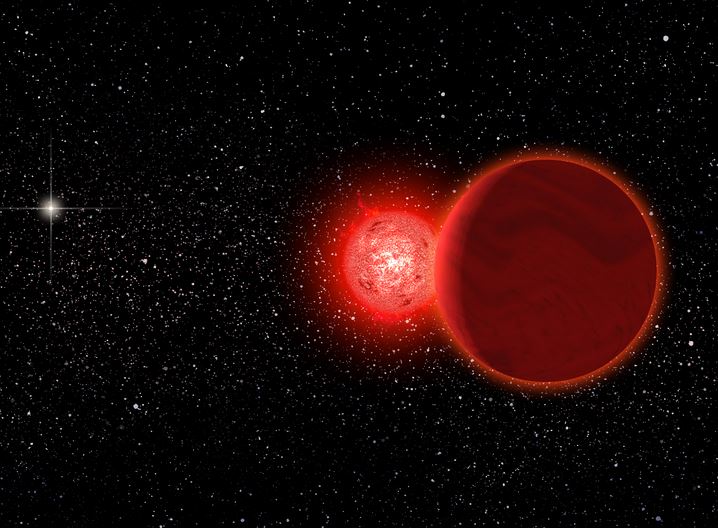A red dwarf passed through our Solar System just 70,000 years ago, researchers from Europe, US, South Africa and Chile reported. The old star passed through the Oort Cloud, our Solar System’s distant cloud with trillions of comets. A red dwarf is a small, relatively cool star.
No other star ever came so close to Earth, scientists say, five times closer than Proxima Centauri, our current nearest star (after the Sun).
The study, led by Associate Professor Eric Mamajek, from the University of Rochester in New York, has been published in the academic journal Astrophysical Journal Letters (citation below).

An artist’s conception of Scholz’s star and its brown dwarf companion (darker one) during its flyby of the solar system 70,000 years ago. The Sun (left, background) would have appeared as a brilliant star. (Credit: Michael Osadciw/University of Rochester)
Mr. Mamajek and colleagues analyzed the speed and trajectory of a low-mass star system dubbed “Scholz’s star”, in honor of Ralf-Dieter Scholz who first reported the discovery of the dim nearby star in 2013.
0.8 light years from Earth
According to the dwarf star’s trajectory, about 70,000 years ago it passed approximately 0.8 light years (52,000 astronomical units) from Earth, i.e. about 8 trillion kilometers or 5 trillion miles. For lay people it may seem a very long way away, the scientists insist that astronomically it was extremely close. Proxima Centauri, the closest star to our Solar System, is 4.2 light years from Earth.
Prof. Mamajek became interest in the dwarf star during a conversation with co-author Dr. Valentin Ivanov, from the European Southern Observatory. Scholz’s star had a unique mix of features – despite being just 20 light years away today, which is still astronomically fairly close, it showed very slow motion across the sky (slow tangential motion).
Dr. Ivanov and colleagues took radial measurements (radial velocity is the speed of the star along the line of sight of an observer) and found that the star was moving almost directly away from our Solar System at very high speed.
“Most stars this nearby show much larger tangential motion. The small tangential motion and proximity initially indicated that the star was most likely either moving towards a future close encounter with the solar system, or it had ‘recently’ come close to the solar system and was moving away.”
“Sure enough, the radial velocity measurements were consistent with it running away from the Sun’s vicinity – and we realized it must have had a close flyby in the past.”

Eric Mamajek is Associate Professor at the Department of Physics and Astronomy, University of Rochester. (Image: University of Rochester)
To be able to work out the star’s trajectory, the scientists needed both the tangential and radial velocity data. Dr. Ivanov and colleagues had recently discovered the star by measuring its spectrum and radial velocity via Doppler shift (a change in frequency due to the Doppler effect).
These measurements were carried out using spectrographs on the Magellan telescope at Las Campanas in Chile and the Southern African Large Telescope.
As soon as the team had gathered and analyzed all the data, they calculated that Scholz’s star was traveling away from our Solar System and tracked it back in time to a position about 70,000 years ago, when according to their models, it came closest to our Sun.
When is the next star flyby?
The next star expected to come closest to our Solar System is the so-called “rogue star” HIP 85605, which was forecast to pass close to us in about 240,000 to 470,000 years’ time.
However, Prof. Mamajek and colleagues have shown that HIP 85605 is about 200 light years away, ten times further than original estimates. According to their newly calculated trajectory, it would not come close to the inner Oort Cloud.
Prof. Mamajek worked with Caltech graduate student Scott Barenfeld to simulate 10,000 orbits for the star, taking into account its position, velocity and distance, our galaxy’s gravitational field, and the statistical uncertainties in all these measurements. In 98% of the 10,000 simulations, the star will pass through the outer Oort, and only within the inner Oort cloud in one of the simulations.
If it passes through the inner Oort it could trigger comet showers.
Even though Scholz’s star’s close flyby probably had little impact on the Oort Cloud, Prof. Mamajek pointed out that “other dynamically important Oort Cloud perturbers may be lurking among nearby stars.”
The European Space Agency Gaia satellite, which was launched recently, will map out the distances and measure the velocities of more than one billion stars. The data it gathers will help astronomers determine which other stars came or will come close to us. Gaia was the ancient Greek goddess of Earth.
Would our ancestors have seen Scholz’s star?
Scholz’s star is a small, dim red dwarf in the constellation of Monoceros, approximately 20 light years away. During its close flyby with our Solar System, it would not have been visible without sophisticated equipment. It would have been a 10th magnitude star, about 50 times fainter than one that can normally be seen with the naked eye at night.
However, it is magnetically active, meaning it can flare and for a brief period become thousands of times brighter. During rare flaring moments, our ancient human ancestors may have seen it in the night sky 70,000 years ago for a few minutes or hours at a time.
Scholz’s star, whose mass is about 8% that of the Sun, is part of a binary star system. Its companion, a brown dwarf, has a mass about 6% that of the Sun. Brown dwarfs do not have enough mass to fuse hydrogen in their cores like a star, but they are still far bigger than gas giant planets like Jupiter.
Citation: “The Closest Known Flyby of a Star to the Solar System,” Eric E. Mamajek, Scott A. Barenfeld, Valentin D. Ivanov, Alexei Y. Kniazev, Petri Väisänen, Yuri Beletsky, and Henri M. J. Boffin. Astrophysical Journal Letters. Published Feb 12, 2015. DOI: 10.1088/2041-8205/800/1/L17.
